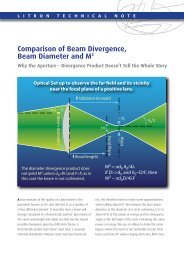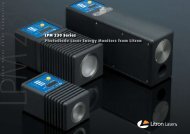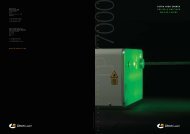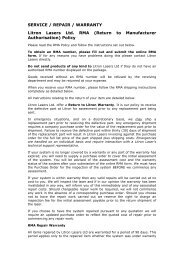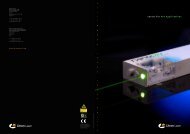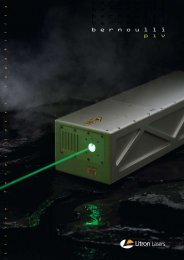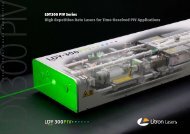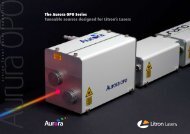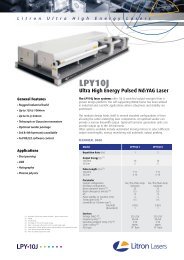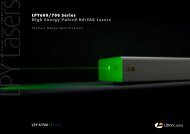You also want an ePaper? Increase the reach of your titles
YUMPU automatically turns print PDFs into web optimized ePapers that Google loves.
<strong>Litron</strong> <strong>Lasers</strong> Ltd.<br />
8 Consul Road<br />
Rugby<br />
Warwickshire CV21 1PB<br />
England<br />
Tel (0)1788 574444<br />
Fax (0)1788 574888<br />
Email sales@litron.co.uk<br />
www.litronlasers.com<br />
<strong>Nano</strong> Series Ultra Compact Pulsed Nd:YAG <strong>Lasers</strong>
The <strong>Nano</strong> Series Superior Performance Through Attentive Design<br />
The <strong>Nano</strong> series of pulsed Q-switched Nd:YAG lasers have<br />
been designed to satisfy the demands of customers today.<br />
With industry leading performance in every respect, and<br />
unsurpassed design and build quality, the <strong>Nano</strong> series sets<br />
the new benchmark for laser systems today.<br />
Spectroscopy<br />
range of laser systems has been attended to in great detail,<br />
Remote Sensing<br />
Photochemistry<br />
maintenance. Heed has been paid to comments from<br />
resulting in useable and serviceable systems have been<br />
Non-Linear Optics<br />
OPO Pumping<br />
Ablation<br />
PIV<br />
ESPI<br />
LIDAR<br />
LIBS<br />
LIF<br />
World class performance results only from world class<br />
design. During the design process every aspect of the <strong>Nano</strong><br />
leading to a range of laser systems that are rugged, reliable,<br />
and which perform optimally with little need for<br />
customers and service engineers, and design features<br />
incorporated wherever possible. For example, simple<br />
flashlamp change without the need for either complete<br />
removal of the pumping chamber or optical realignment,<br />
easily removable and cleanable optics, an electronic<br />
intra-cavity safety shutter and a latched interlock suite are<br />
but a few of the features which set <strong>Litron</strong>’s <strong>Nano</strong> series<br />
apart from the competition.<br />
As with any piece of equipment it is the performance of the<br />
device, both in terms of reliability and in terms of<br />
specification, which define its suitability for an application.<br />
Nowadays, applications for laser systems are extremely<br />
varied, and as such a ‘one system suits all’ approach is rarely<br />
acceptable. On this basis the <strong>Nano</strong> range comprises four<br />
laser head models and three power supplies allowing<br />
Q-switched outputs from 10mJ per pulse to 500mJ per<br />
pulse at repetition rates of up to 100Hz. This allows us to<br />
provide our customers with a solution tailored to their<br />
specific need, saving both time and expense.
Engineering Excellence<br />
MecHANicAL<br />
Implicit in good design is good engineering. When considering the important mechanical aspects of a<br />
laser system, mechanical and thermal stability and insensitivity to misalignment coupled with ease of<br />
maintenance come first. The <strong>Nano</strong> series laser heads are machined from solid aluminium, and the optical<br />
resonator is an integral part of the aluminium body. This results in a mechanically rigid and rugged<br />
design, whose thermal stability is as good as a self supporting invar structure.<br />
The pumping chamber is machined from 316 surgical grade stainless steel, and houses a pair of close<br />
coupled ceramic reflectors. The pumping chamber is thermally decoupled from the resonator resulting in<br />
good thermal stability even at high flashlamp power loadings. The ceramic reflectors allow very<br />
uniform pumping of the laser rod, and as a direct consequence exceptional output beam quality. Other<br />
aspects of beam quality, such as pointing stability, are affected by the efficiency with which the laser rod<br />
is cooled. By ensuring the laser rod is cooled before the flashlamp, and by ensuring a large turbulent<br />
flow over the laser rod, the pulse to pulse stability and the pointing stability of the <strong>Nano</strong> series are<br />
amongst the best available. Also the serial flow ensures very uniform cooling of the laser rod and<br />
flashlamp, leading to a longer flashlamp life. This is because there are no voids in the cooling as are<br />
commonly seen in parallel flow arrangements, where flashlamps may even distort due to extreme<br />
localised heating.<br />
De-ionised water is corrosive: the cooling system therefore comprises entirely of hard plastic or stain-<br />
less steel parts which are totally inert to de-ionised water. As a result there is no risk of contamination<br />
from the cooling system compromising laser performance, and further there is no need to worry about<br />
draining or running the laser system should it stand idle for protracted periods of time. An easily<br />
changeable de-ioniser cartridge is standard on all power supplies. The cooling system in all of the power<br />
supplies is a closed loop with a water to air heat exchanger. This means that the entire laser system is<br />
totally self contained with no need for an external coolant supply.<br />
OPTicAL<br />
Optically the KD*P Pockels cell is mounted in a fully sealed housing, eliminating any possibility of crys-<br />
tal damage due to moisture or dirt. All optics are coated with hard dielectric coatings that have<br />
extremely high damage thresholds. The diffuse cavity reflectors are arranged to give the highest pump<br />
uniformity of the laser rod, and therefore the best beam quality.<br />
in any optical system, the need may arise to clean the optics. To this end, all optics are fully<br />
demountable for cleaning. Alignment of the laser system is by two adjustable mirror mounts that can<br />
be firmly locked in place. Whilst cleaning of the optics and system alignment should not normally be<br />
necessary, the design of the system allows the customer to undertake such procedures quickly and<br />
easily, without the need for any expensive service visits or protracted periods of down time.<br />
<strong>Nano</strong> S<br />
<strong>Nano</strong> L<br />
<strong>Nano</strong> T<br />
The <strong>Nano</strong> <strong>Range</strong> – A solution for every problem<br />
There are three ‘end user’ laser heads in the <strong>Nano</strong> series, the <strong>Nano</strong> S, the <strong>Nano</strong> L and the<br />
<strong>Nano</strong> T. All three laser heads are fundamentally the same in terms of construction: they are<br />
all machined from a solid block of aluminium, have electronic intra-cavity safety shutters,<br />
fully sealed Pockels cells, stainless steel close coupled pumping chambers and easily<br />
adjustable and cleanable mirrors and optics.<br />
The design of the <strong>Nano</strong> range facilitates the connection of any power supply to any head.<br />
This benefits the customer both in terms of size and cost of the laser system, as the system<br />
130mJ<br />
provided will be optimally tailored to the requirements of the customer.<br />
ThE NANO S<br />
The <strong>Nano</strong> S is one of the smallest ‘end user’ laser systems of its type in the world. its footprint is just 272mm x<br />
82mm x 62mm. it offers the user energies of up to 130mJ per pulse and repetition rates of up to 50Hz. it is<br />
supplied with a conventional stable resonator, and can be configured to give TeM00 if required, by the inclusion<br />
350mJ<br />
required an intra-cavity aperture can be fitted to give a TeM00 output.<br />
500mJ<br />
of an intra-cavity aperture.<br />
ThE NANO L<br />
The <strong>Nano</strong> L has a footprint of only 360mm x 96mm x 74mm. Output energies of up to 350mJ and repetition<br />
rates of up to 100Hz are available. it can be supplied with either a stable resonator or with Gaussian optics. if<br />
ThE NANO T<br />
The <strong>Nano</strong> T has a footprint of 500mm x 96mm x 74mm. Output energies of up to 500mJ and repetition rates of<br />
up to 100Hz are available. The <strong>Nano</strong> T can be configured with a stable, telescopic or Gaussian resonator, and<br />
can be fitted with an intra-cavity aperture to give a TeM 00 output.
Near field beam profile<br />
of <strong>Nano</strong> S with stable<br />
resonator at 1064nm.<br />
Near field profile of<br />
<strong>Nano</strong> L running<br />
TEMoo at 1064nm.<br />
Resonator Types<br />
TEM STABLe ReSONATOR<br />
oo<br />
A stable resonator provides the greatest flexibility in terms of output energy and repetition rate, as<br />
both parameters can be varied with minimal effect upon the alignment of the system. in general, the<br />
output of such systems is multi-mode. With the addition of an intra-cavity aperture, a TeM 00 output<br />
can easily be realised, but at the expense of overall efficiency.<br />
GAuSSiAN ReSONATOR<br />
Gaussian<br />
In a Gaussian system, graded reflectivity mirrors are used, and form part of an unstable resonator. Such<br />
systems give a high energy single transverse mode with a low beam divergence. However this optical<br />
configuration does have drawbacks. The thermal lens formed by the laser rod is part of the optical<br />
arrangement. Such systems will therefore only work properly at one repetition rate, when the thermal<br />
loading on the laser rod is constant. As a direct result of this, the laser is factory set at one pulse<br />
repetition frequency and output energy. To overcome these limitations, which are governed by the<br />
physics of the system, <strong>Litron</strong> offers two options. The<br />
first option, the pulse repetition rate<br />
divider, allows the user to divide the set<br />
repetition rate by 2, 4, 8 or 16. This works<br />
by allowing the flashlamp to pulse at a set<br />
frequency, thus maintaining almost the<br />
same thermal lens on<br />
the laser rod, but only<br />
switching the Pockels<br />
cell on the desired pulses<br />
(i.e. every other pulse for<br />
divide by two operation). The second option is a motorised variable optical<br />
attenuator. By the use of an extra-cavity polariser and half-wave plate, the<br />
output energy of the laser can be attenuated, whilst maintaining the<br />
Multimode<br />
beam quality and divergences required.<br />
213nm<br />
in a system fitted with Gaussian optics, the pulse length tends to be shorter than in a conventional sta-<br />
ble resonator. This increases the peak power density that is seen by the resonator optics and subse-<br />
quently by any beam handling optics that may be used.<br />
TeLeScOPic ReSONATOR<br />
To obtain high energy low divergence beams, the preferred method is the use of a telescopic resona-<br />
tor. in this configuration, an intra-cavity telescope is used to reduce the beam diameter in the rear leg<br />
of the resonator. This has the effect of making the resonator appear longer, increasing the losses in the<br />
higher order modes, leading to a superior output beam with very low divergence. With no optical adjust-<br />
3<br />
4<br />
1<br />
2<br />
Rear Mirror<br />
Q-Switch<br />
Nd:YAG Rod<br />
Output Coupler<br />
Graded Reflectivity<br />
Output Coupler<br />
Rear Mirror Aperture<br />
Telescope Q-Switch Nd:YAG Rod<br />
Output Coupler<br />
Schematics showing<br />
oscillator design.<br />
1) Stable<br />
2) Gaussian<br />
3) Telescopic Multimode<br />
4) Telescopic TEMoo 266nm<br />
Distribution of the output energy per<br />
pulse for 500 consecutive shots.<br />
<strong>Range</strong> of histogram ± 1% ofmean<br />
value. Standard devitaion ~0.3%.<br />
355nm<br />
532nm<br />
ment at all, the laser can be varied over a wide range of pulse energies and repetition<br />
rates, whilst maintaining a high quality, low divergence beam. With slight adjustment<br />
to the telescope (a simple procedure) the full range of energies and repetition rates<br />
from single pulse to the maximum can be achieved. For high energy TeM 00 beams, an<br />
intra-cavity aperture can be fitted behind the telescope. Varying the sizes of these apertures allows<br />
output beams that are to within 15% of the diffraction limit to about 2.5 times the diffraction limit. That<br />
is from an almost pure Gaussian TeM 00 to full energy in a uniform spatial profile. The output from a<br />
telescopic resonator is longer and smoother temporally, making it the system of choice for pumping dye<br />
lasers or optical parametric oscillators. Such arrangements, by virtue of the longer pulse length, are much<br />
less prone to optical damage than Gaussian systems.<br />
OSciLLATOR AMPLiFieR SySTeMS<br />
In order to generate high energy laser outputs, or to generate medium energy outputs at very high<br />
repetition rates, the use of an amplifier stage is often beneficial. An oscillator amplifier is advantageous<br />
over a single high energy oscillator for several reasons. in an oscillator, the energy that can be extracted<br />
is governed by the Q-switch hold off, parasitic oscillations and amplified spontaneous emission. in an<br />
amplified system, the oscillator is not usually run at its maximum output (as dictated by the maximum<br />
stored energy of the laser rod), therefore the peak powers are lower through the cavity optics and<br />
Pockels cell, leading to longer life and more reliable service. When using an oscillator and amplifier to<br />
obtain output energies greater than about 500mJ, the near field spatial profile is usually better,<br />
containing less structure than an equivalent single oscillator yielding the same output.<br />
A range of amplifiers can be fitted to the <strong>Nano</strong> series, in an oscillator amplifier<br />
arrangement, the oscillator is typically one of the standard <strong>Nano</strong> range. The output is<br />
then folded to pass through the amplifier rod. The amplifier design uses a single lamp<br />
pumped rod housing, of the same design as those used in the oscillators. With the use<br />
1064nm<br />
of a suitable amplifier stage, outputs of >1200mJ are available from the <strong>Nano</strong> series.<br />
HARMONic GeNeRATiON<br />
<strong>Litron</strong> offers a full range of harmonic generation and separation modules, giving<br />
the customer access to 532nm, 355nm, 266nm and 213nm. There are two types<br />
of harmonic housing available: a short form housing and a long form housing.<br />
These can be added and removed as required and can usually be retrofitted. The<br />
short housing is ideal for applications which require only 532nm, this contains a frequency doubling<br />
crystal and dichroic separation mirrors. The long harmonic housing can hold a frequency doubler, or a<br />
frequency doubler and tripler, or a frequency doubler and quadrupler, and dichroic separation mirrors.<br />
Typically KTP or LBO are used as frequency doublers, LBO or BBO are used as frequency triplers and BBO<br />
is used as a frequency quadrupler. Temperature stabilisation of the crystals is available.
6<br />
ELECTRoNiC SAFETY ShUTTER<br />
The <strong>Nano</strong> Uncovered<br />
All <strong>Nano</strong> models (with the exception of the <strong>Nano</strong> O)<br />
come with a solenoid driven safety shutter. This shutter<br />
automatically closes when the laser turns off; therefore<br />
when the laser is started the shutter will be closed. This<br />
makes the laser safer when used in a laboratory. As a<br />
further safety measure, the position of the shutter is<br />
monitored by the system control. Should the actual<br />
position of the shutter and<br />
the required position of the<br />
shutter not be in agreement<br />
the laser will automatically<br />
turn off.<br />
7<br />
RUGGEd STEEL CLAd UmBiLiCAL<br />
All of the <strong>Nano</strong> range are fitted with rugged PVc covered<br />
steel clad umbilicals to carry the necessary services to the<br />
laser head. The umbilical diameter on the <strong>Nano</strong> O and<br />
<strong>Nano</strong> S heads is 25mm and on the <strong>Nano</strong> L and <strong>Nano</strong> T<br />
heads is 33mm.<br />
1<br />
PUmPiNG ChAmBER<br />
5<br />
QUARTER-WAVE PLATE ANd PoLARiSER<br />
Hold-off is achieved by means of a polariser and a quarter-wave plate. Light passes<br />
through the polariser and is horizontally polarised, it passes through the Pockels cell,<br />
which with no bias voltage applied does not affect the polarisation. As it passes<br />
through the quarter-wave plate it is resolved into two polarisations, one of which<br />
undergoes a 90˚ phase shift with respect to the other. The light leaving the quarterwave<br />
plate is thus circularly polarised. upon reflection from the rear mirror, the light<br />
once again passes through the quarter-wave plate and again one polarisation<br />
undergoes a further 90˚ phase shift, leading to vertically polarised light exiting the<br />
quarter-wave plate. This light passes back through the Pockels cell and is reflected out<br />
of the cavity by the polariser, preventing any pulse build up. When bias volts are<br />
applied to the Pockels cell, an additional 90˚ phase shift in one polarisation is added<br />
The most important requirement for high beam quality, both in terms of spatial profile and pointing<br />
stability, is that the pumping chamber is designed properly. <strong>Litron</strong>’s pumping chambers are machined<br />
from solid 316 grade stainless steel. They contain two extremely close coupled diffuse ceramic reflectors,<br />
which give rise to a highly uniform pumping of the laser rod, something not<br />
achieved with elliptical specular reflectors. The laser rod and the flashlamp are<br />
separated by a tough ionic glass filter that totally absorbs all of the uV radiation<br />
emitted by the flashlamp. Such radiation is of no use in pumping the laser rod,<br />
but can damage the rod over a period of time. The result of such a design is a<br />
system that will work reliably for many years with no problems. The flashlamp<br />
can be removed and replaced within 5 minutes, with no need for optical<br />
realignment at all.<br />
4<br />
6<br />
1<br />
in each pass, this leads to a<br />
total phase shift of 360˚ or 0˚,<br />
and therefore horizontally<br />
polarised light is returned and<br />
passes through the polariser<br />
allowing the laser pulse to build up. An advantage of this<br />
method, over using the Pockels cell itself as a quarterwave<br />
plate (by biasing it and then removing the voltage<br />
at the peak inversion), is that there is no chance of postlasing<br />
as the bias voltage is applied to the Pockels cell for<br />
only long enough for the Q-switched pulse to emerge.<br />
2<br />
3<br />
PoCkELS CELL<br />
The Q-switch in the <strong>Nano</strong> S is KD*P. The crystal is<br />
5 2 5<br />
totally sealed within a rugged housing and immersed<br />
in an index matching fluid. Such a design of Pockels<br />
cell is well proven and it has the added benefit of<br />
protecting the hygroscopic KD*P from any moisture<br />
that it may encounter during the flashlamp change<br />
procedure, or if the laser head is uncovered in a<br />
humid laboratory. Avalanche transistors are used to<br />
switch the necessary quarter-wave voltage onto the<br />
crystal, and this can be achieved at repetition rates of up to 1kHz with<br />
electronic jitter of
ApplicAtions include<br />
SPEcTROScOPy<br />
REMOTE SENSING<br />
PhOTOchEMISTRy<br />
NON-LINEAR OPTIcS<br />
OPO PUMPING<br />
ABLATION<br />
PIV<br />
ESPI<br />
L I D A R<br />
LIBS<br />
LIF<br />
Applications<br />
PARTicLe iMAGe VeLOciMeTRy (PiV)<br />
PiV has over the last few years become a commonplace technique, both industrially and in research<br />
establishments. A full range of PiV laser systems is available with outputs from 20 – 100mJ per pulse,<br />
and adjustable pulse separations of sub microsecond to milliseconds. PiV laser systems use two laser<br />
oscillators with orthogonal polarizations, the beams are combined with dielectric polarisers and then<br />
frequency doubled.<br />
cuSTOM LASeR SySTeMS<br />
Due to the pseudo modular design of the <strong>Nano</strong> range of laser systems, custom laser systems are often<br />
configurable from existing parts. For this reason, along with our experience in the manufacture of laser<br />
systems, if a product does not exactly meet your required specification, we will gladly discuss providing<br />
you with one that does. This is often achievable with little or no extra cost.<br />
Other laser media such as erbium glass (1.5µm), erbium yAG (2.94µm), holmium yAG (2.01µm), ruby<br />
(694nm), and neodymium glass laser systems are also available upon request.<br />
SAFeTy<br />
Perhaps the single most important aspect of any equipment is its safety. <strong>Litron</strong>’s laser systems have<br />
been designed with safety as one of the prime constraints. All covers are interlocked, so that the laser<br />
cannot be run if any cover is removed. This reduces the risk of stray radiation from within the device<br />
causing damage. All high voltages are covered with insulating covers, within an interlocked case. The<br />
system cannot be run when any high voltages are exposed to the user. An electronic safety shutter with<br />
additional verification is standard on all ‘end user’ systems, so when the laser is started it will not emit<br />
any radiation. An external interlock is standard and can be connected to a laboratory door, so that the<br />
laser system will switch off should the door be opened. This interlock can be overridden in situations<br />
when an external interlock is not a requirement.<br />
<strong>Litron</strong>’s laser systems are designed to comply with BS eN 60825-1 (Safety of Laser Products – equipment<br />
classification, Requirements and user’s Guide) and BS eN 60101-1 (Safety Requirements for electrical<br />
equipment for Measurement, control and Laboratory use).<br />
Power Supplies<br />
<strong>Litron</strong> offers a complete range of fully featured power supplies, with output powers from 200W up to<br />
2kW from a single charger. All power supplies utilize the latest resonant iGBT switching technology for<br />
maximum efficiency. The flashlamps in all systems are fully simmered and the Pockels cell is driven<br />
using avalanche transistors. The system control contains a suite of latched interlocks, allowing<br />
quick and easy fault diagnosis.<br />
The smallest power supply in the range, the LPu250, measures only<br />
202mm (wide) x 320mm (high) x 382mm (long) and contains a 250W<br />
capacitor charger, simmer, Q-switch driver, all system control and an<br />
integral water to air heat exchanger. The LPu250 is fully power factor<br />
corrected and will run off any mains input between 90 and 260V.<br />
control of the laser is via a remote control box, which<br />
allows control of all of the system features, these are:<br />
laser start and stop, pump on and off, pulse repetition rate,<br />
output energy and shutter position. Standard TTL controls give access<br />
to Q-switch and lamp synchronisation and triggering, allowing quick<br />
and easy integration into almost any set up. An optional RS232<br />
interface and computer software suite gives complete system control from a Pc.<br />
The LPu500 has all of the features of the LPu250 but contains a 500W capacitor<br />
charger and a more powerful cooler.<br />
The LPu1000 is again a fully featured power supply containing a<br />
1kW capacitor charger. This power supply has been designed<br />
such that slave charger units can be added to increase the<br />
power capability of the unit. This allows very high energy or<br />
high repetition rate systems to be constructed with ease.<br />
OeM power supplies are supplied in standard 19” rack mount modules. The smallest of these is a 200W<br />
complete power supply which includes a full closed loop cooling system, all contained in a unit that is<br />
just 3u (133mm) high.<br />
All power supplies (up to 1kW) can be supplied to optionally run off Dc inputs of 24 – 100VDc, making<br />
them ideally suited to airborne applications or field use, where a Dc supply from batteries is available.<br />
For custom systems, the power supplies can easily be modified to give higher capacitor charge rates or<br />
specific system control requirements.<br />
LPU500 integrated power<br />
supply and cooler.<br />
LPU250 integrated power<br />
supply and cooler.
Accessories<br />
VARiABLe OPTicAL ATTeNuATiON<br />
In certain circumstances where the pump energy and repetition rate of the laser system are fixed (e.g.<br />
in a Gaussian resonator), adjustment of the laser output energy may be necessary. For this reason a<br />
variable optical attenuator is offered as an option on all of our laser systems. By the use of a half-wave<br />
plate and polariser, the axial beam energy can be varied. The residual energy can either be dumped<br />
safely or utilized in some way.<br />
Additionally a variable optical attenuator is useful if the temporal profile of the pulse needs to be<br />
maintained at different output energies. As the pump intensity is reduced, the gain of the laser rod<br />
decreases, this leads to a longer Q-switched pulse at lower energies. By keeping the output at a given<br />
level, and using a variable optical attenuator, all pulses will be temporally of similar length.<br />
MecHANicAL AND OPTicAL MOuNTS<br />
A range of mechanical mounts to attach the laser to an optical table and optical mounts such as steer-<br />
ing mirror mounts are available, giving the user maximum flexibility in handling and using the laser<br />
output. All accessories are designed to interface with standard optical tables. Optical breadboards of<br />
up to 600mm x 600mm with M6 holes on a 25mm pitch, along with a complete range of optical<br />
mounts to facilitate the user’s experimental set-up, can be purchased from <strong>Litron</strong> either with a laser<br />
system or as accessories.<br />
OPTiONAL FAST PHOTODiODe<br />
A fast 50Ω terminated photodiode is available as an option on all of the laser heads in the range. This<br />
allows monitoring of the temporal profile of the Q-switched laser output when used in conjunction<br />
with a suitable oscilloscope.<br />
cO-AxiAL DiODe LASeR<br />
An optional diode laser can be fitted behind the rear mirror of the<br />
laser to provide a visible aiming beam for the laser output.<br />
LPM530 Transfer energy monitors<br />
allow accurate in-line energy<br />
monitoring of system performance.<br />
A full software suite is included<br />
with every energy monitor.<br />
ENERGY moNiToRiNG<br />
<strong>Litron</strong> manufactures a comprehensive range of laser energy monitors. These are photodiode based<br />
instruments and allow extremely accurate analysis and measurement of laser performance.<br />
Unlike conventional energy measurement devices, <strong>Litron</strong>’s range of monitors can measure every pulse<br />
from the laser system, rather than averaging the energy as many calorimetric devices do. This leads to<br />
unrivalled accuracy and flexibility of measurements. Typically the pulse to pulse measurement<br />
repeatability of these devices is better than 0.2%. The damage threshold of these energy monitors is<br />
extremely high, as the optics train scatters rather than absorbs the light. The input optic is ground<br />
fused silica, and is arranged such that easy removal is possible should it be damaged for any reason.<br />
All energy monitors feature a bright 4 digit display and an RS232 output, which allows data-logging of<br />
the laser performance. A comprehensive software suite is provided as standard. For further<br />
information on <strong>Litron</strong>’s range of energy monitors please refer to the specific data sheets.<br />
<strong>Litron</strong>'s range of photodiode laser energy monitors,<br />
with 30mm and 50mm input apertures allow accurate<br />
measurement of laser performance.
28<br />
27.5<br />
<strong>Nano</strong> S laser head arrangement<br />
28.5<br />
27.5<br />
All dimensions in mm.<br />
170<br />
170<br />
<strong>Nano</strong> L laser head arrangement<br />
28.5<br />
34<br />
170<br />
<strong>Nano</strong> T laser head arrangement<br />
28.5<br />
34<br />
LPU500 power supply unit<br />
170<br />
The <strong>Nano</strong> <strong>Range</strong><br />
28<br />
27.5<br />
27.5<br />
450.5<br />
19" Rackmount<br />
411 268.5 382<br />
202<br />
100<br />
28.5 100<br />
59.6<br />
Long harmonic housing Short doubler housing Laser head<br />
34 34<br />
28.5 110<br />
67.5<br />
Long harmonic housing Short doubler housing Laser head<br />
34 34<br />
28.5 110<br />
67.5<br />
Long harmonic housing Short doubler housing Laser head<br />
74<br />
74<br />
55<br />
62<br />
54<br />
96<br />
96<br />
78<br />
82<br />
LPU250 power supply unit<br />
27.5<br />
27.5<br />
3U<br />
230<br />
272<br />
320<br />
360<br />
500<br />
Remote control unit<br />
180<br />
52.5<br />
145<br />
MODEL SELEcTION GUIDE<br />
Model Output energy Resonator Harmonics Maximum Standard<br />
at 1064nm (1) Types (2) Available (3) Repetition electronic<br />
Rate (1) Shutter<br />
<strong>Nano</strong> S 130mJ S, TeM 00 2,3,4,5 50Hz yes<br />
<strong>Nano</strong> L 350mJ S,G,TeM 00 2,3,4,5 100Hz yes<br />
<strong>Nano</strong> T 500mJ S,G,T,TeM 00 2,3,4,5 100Hz yes<br />
<strong>Nano</strong> T +Amplifier Stage 1200mJ S,G,T,TeM 00 2,3,4,5 100Hz yes<br />
1 The maximum output energy is dependent upon the maximum repetition rate. The output energy for a given repetition rate is determined by the mean flashlamp power.<br />
Please contact <strong>Litron</strong> for further details.<br />
2 S means stable resonator, G means Gaussian resonator, T means telescopic resonator, and TeM 00 means that a TeM 00 output option is available.<br />
3 Harmonics are optional.<br />
our policy is to improve the<br />
design and specification of<br />
our products. The details<br />
given in this brochure are not<br />
to be regarded as binding.<br />
PB0130-1 may 2003<br />
© <strong>Litron</strong> <strong>Lasers</strong> Ltd.<br />
Cm3 Printed in England




